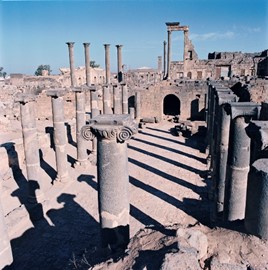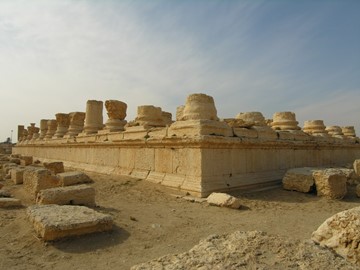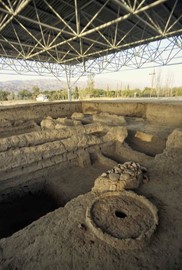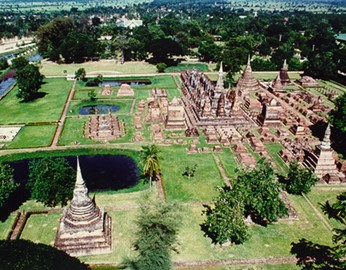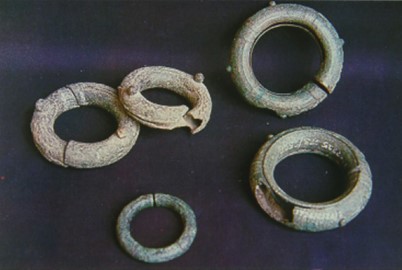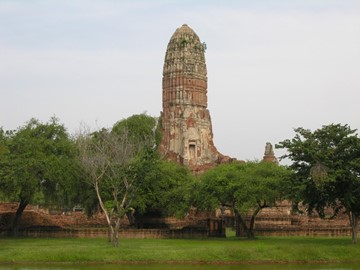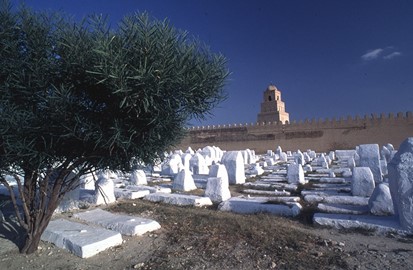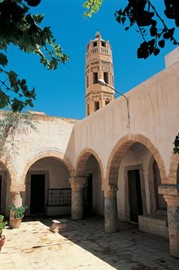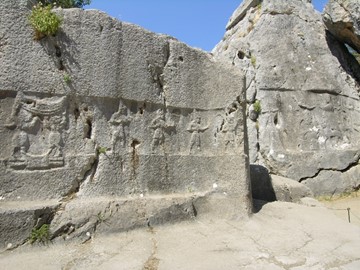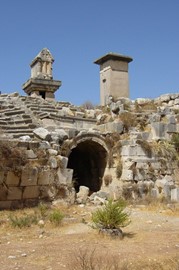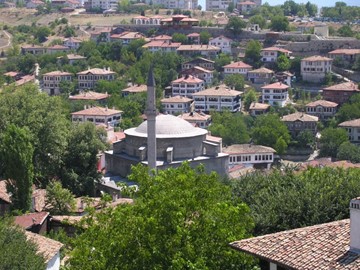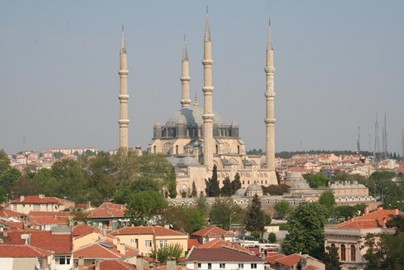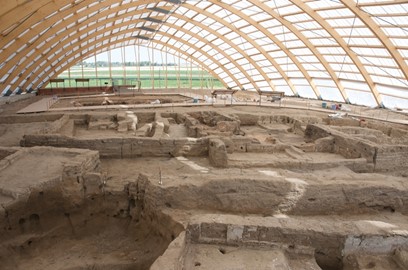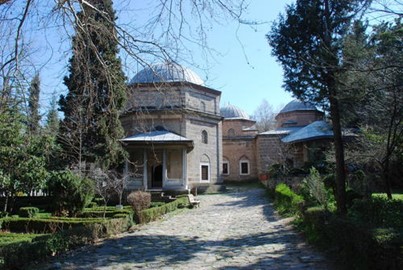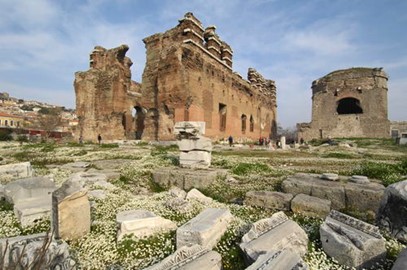category :: cultural
Damascus
The Ancient City of Damascus, a UNESCO World Heritage site in Syria, is one of the oldest continuously inhabited cities in the world, with a history dating back over 11,000 years. Renowned for its well-preserved medieval architecture, the city features significant landmarks like the Umayyad Mosque, a masterpiece of Islamic design, and bustling souks that reflect its rich cultural and commercial past. Its strategic location made it a vital hub for trade and civilization, blending influences from Roman, Byzan... Read More
Bosra
The Ancient City of Bosra, a UNESCO World Heritage site in Syria, is renowned for its well-preserved Roman, Byzantine, and Islamic architecture. This historic city features a remarkable 2nd-century Roman theater, one of the best-preserved in the world, alongside ancient mosques, churches, and a sprawling network of ruins. Bosra’s significance lies in its role as a key trading hub along ancient caravan routes, reflecting a rich blend of cultural influences over centuries. Today, it stands as a testament to S... Read More
Palmyra
Palmyra, a UNESCO World Heritage site in Syria, is an ancient city renowned for its well-preserved Roman-era ruins. Dating back to the 1st and 2nd centuries, it served as a vital trading hub along the Silk Road, blending Greco-Roman architecture with local influences. Notable landmarks include the grand colonnaded street, the Temple of Bel, and the iconic Tetrapylon, showcasing its historical and cultural significance. Despite suffering damage during recent conflicts, Palmyra remains a testament to the regi... Read More
Sarazm
Sarazm, a UNESCO World Heritage Site in Tajikistan, is an ancient proto-urban settlement dating back to the 4th millennium BCE, showcasing the early development of human civilization in Central Asia. This archaeological site highlights a thriving Bronze Age community engaged in agriculture, metallurgy, and trade, with evidence of cultural and commercial connections stretching from Turkmenistan to the Indus Valley. Discovered in 1976 and excavated starting in 1977, Sarazm offers a glimpse into a sophisticate... Read More
Sukhothai
Sukhothai, a UNESCO World Heritage site in Thailand, is an ancient city renowned for its historical and cultural significance as the first capital of the Siamese Kingdom in the 13th and 14th centuries. The site features well-preserved ruins, including elegant temples, Buddha statues, and intricate stupas, showcasing the distinctive Sukhothai architectural style that influenced Thai art and culture. It is celebrated as the birthplace of Thai civilization, with its name translating to 'Dawn of Happiness,' ref... Read More
Ban Chiang
Ban Chiang, a UNESCO World Heritage Site in Thailand, is a significant prehistoric archaeological site dating back to 1495 BC, showcasing the earliest evidence of farming, wet-rice agriculture, and bronze tool-making in Southeast Asia. Discovered in 1966, it marks a pivotal stage in human cultural, social, and technological evolution, with findings like red-painted pottery and metal artifacts highlighting a sophisticated early civilization. Designated in 1992, the site features a museum displaying these anc... Read More
Ayutthaya
Ayutthaya, a UNESCO World Heritage site in Thailand, is a historic city founded in 1350 that served as the kingdom's capital until its fall in 1767. Renowned for its impressive ruins, including ancient temples, palaces, and statues, it showcases a blend of Khmer, Sukhothai, and local architectural styles. The site reflects the region's rich cultural and historical significance, drawing visitors to explore its well-preserved remnants and serene riverside setting.
Koutammakou
Koutammakou, the Land of the Batammariba, is a UNESCO World Heritage site located in northeastern Togo, recognized in 2004 for its unique cultural landscape. It is home to the Batammariba people, who are renowned for their distinctive mud tower-houses, known as takienta, which serve as both homes and symbols of Togo’s heritage. These structures, often two stories with flat or conical roofs, reflect the community’s social structure and harmonious relationship with nature, deeply tied to their rituals and bel... Read More
Carthage
Carthage, a UNESCO World Heritage site in Tunisia, is an ancient city founded by the Phoenicians in the 9th century BCE, renowned for its historical significance as a major Mediterranean power. It features impressive archaeological remains, including the Roman Antonine Baths, the Punic Ports, and the Byrsa Hill citadel, showcasing a blend of Phoenician, Roman, and Byzantine influences. Once a rival to Rome, Carthage played a pivotal role in the Punic Wars before its destruction and later reconstruction by t... Read More
Kerkuane
The Punic Town of Kerkuane and its Necropolis, a UNESCO World Heritage site in Tunisia, is a well-preserved archaeological gem from the 6th century BCE. Founded by the Phoenicians, it showcases ancient urban planning with residential quarters, temples, and a sophisticated drainage system, offering a rare glimpse into Punic civilization before its destruction by Rome. The adjacent necropolis features burial chambers and artifacts that highlight the cultural and religious practices of the time. This site stan... Read More
Dougga / Thugga
Dougga, also known as Thugga, is a UNESCO World Heritage site in Tunisia, renowned as the best-preserved Roman small town in North Africa. Originally a Numidian settlement, it flourished under Roman and Byzantine rule, showcasing a rich blend of Libyco-Punic, Roman, and indigenous influences through its well-maintained ruins, including a theater, capitol, and mausoleum. Designated a World Heritage site in 1997, it offers a unique glimpse into ancient daily life and cultural synthesis. Its remote location ha... Read More
Amphitheatre of El Jem
The Amphitheatre of El Jem, a UNESCO World Heritage site in Tunisia, is an impressive Roman-era monument renowned for its well-preserved structure and historical significance. Constructed in the 3rd century AD, this grand amphitheater once hosted gladiatorial contests and public spectacles, showcasing the architectural prowess of the Roman Empire. Its massive stone walls and tiered seating, capable of holding up to 35,000 spectators, stand as a testament to its past grandeur. Today, it remains a striking sy... Read More
Kairouan
Kairouan, a UNESCO World Heritage site in Tunisia, is a historic city renowned for its rich Islamic heritage. Founded in 670 AD, it served as a key center for religious scholarship and trade in North Africa. The Great Mosque of Kairouan, one of the oldest and most prestigious mosques in the Muslim world, stands as a testament to its architectural and cultural significance. Its well-preserved medina, with narrow streets and traditional markets, further highlights its historical importance.
Medina of Sousse
The Medina of Sousse, a UNESCO World Heritage site in Tunisia, is a well-preserved example of an early Islamic fortified city, established during the Aghlabid period (800–909) as a key commercial and military port. Its historic core features a robust kasbah, imposing ramparts, the Great Mosque, and the Ribat—a unique blend of fort and religious structure—reflecting Arabo-Muslim urbanism and coastal defense architecture. The medina’s narrow streets, traditional souks, and Archaeological Museum with its stunn... Read More
Medina of Tunis
The Medina of Tunis, a UNESCO World Heritage site in Tunisia, is a historic urban center founded in 698 AD around the Zitouna Mosque, flourishing under the Almohad and Hafsid dynasties from the 12th to 16th centuries as one of the Islamic world’s greatest cities. It features a well-preserved maze of narrow streets, souks, and over 700 monuments, including palaces, mosques, and mausoleums, reflecting a rich blend of Arab-Muslim architecture and cultural heritage. Recognized in 1979, it exemplifies traditiona... Read More
Divrigi
The Great Mosque and Hospital of Divriği, a UNESCO World Heritage site in Turkey, is an exceptional example of 13th-century Seljuk architecture, completed in 1228-1229 under the Mengujekids. This twin-structure complex seamlessly blends a richly ornamented mosque with an intricately designed hospital, showcasing masterful stone carvings and innovative engineering. Renowned for its elaborate portals and unique geometric patterns, it reflects a harmonious fusion of art, science, and spirituality. Its historic... Read More
Hattusha
Hattusha, the ancient capital of the Hittite Empire, is a UNESCO World Heritage site in Turkey renowned for its historical and archaeological significance. Flourishing during the Bronze Age, it served as a political and religious center, featuring impressive ruins such as temples, royal residences, and fortifications. Excavations have uncovered cuneiform tablets, offering insights into Hittite administration and culture. Today, it stands as a testament to one of the most influential civilizations of the anc... Read More
Nemrut Dag
Nemrut Dağ, a UNESCO World Heritage site in Turkey, is renowned for its ancient mountaintop sanctuary built in the 1st century BC by King Antiochus I of the Commagene Kingdom. The site features massive stone statues of gods, eagles, and lions, dramatically perched at an elevation of over 2,000 meters, offering a striking blend of Hellenistic, Persian, and local artistic influences. These colossal figures, some standing up to 9 meters tall, guard a royal tomb and are celebrated for their historical and cultu... Read More
Xanthos Letoon
Xanthos-Letoon, a UNESCO World Heritage site in Turkey, is a remarkable archaeological complex showcasing the ancient Lycian civilization's unique architecture and cultural heritage. Xanthos, the capital of Lycia, blends Lycian traditions with Hellenic influences, evident in its distinctive rock-cut tombs and pillar-mounted sarcophagi, while Letoon served as a significant religious sanctuary dedicated to the goddess Leto. The site is renowned for its well-preserved ruins, including a theater, temples, and i... Read More
Safranbolu
The City of Safranbolu, a UNESCO World Heritage site in Turkey, is renowned for its well-preserved Ottoman architecture and historical significance. This charming city features traditional wooden houses, cobblestone streets, and ancient mosques, offering a glimpse into Turkey’s rich cultural past. Once a thriving trade hub along the Silk Road, it is particularly famous for its saffron production, which inspired its name. Today, Safranbolu attracts visitors with its authentic ambiance and historical landmark... Read More
Troy
The Archaeological Site of Troy, a UNESCO World Heritage site in Turkey, is renowned for its historical significance as the setting of the Trojan War from ancient Greek mythology. Excavations have revealed multiple layers of settlements spanning over 3,000 years, showcasing a blend of Bronze Age fortifications, temples, and artifacts. This site offers valuable insights into early urban development and intercultural exchanges in the ancient world. Today, it stands as a testament to human history, attracting ... Read More
Selimiye Mosque
The Selimiye Mosque, a UNESCO World Heritage site in Turkey, is an architectural masterpiece designed by the renowned Ottoman architect Mimar Sinan in the 16th century. Completed in 1575, it exemplifies the pinnacle of Ottoman Islamic architecture with its grand central dome, slender minarets, and intricate interior decorations featuring Iznik tiles and calligraphy. Built during the reign of Sultan Selim II, the mosque reflects the empire’s cultural and artistic zenith, serving as both a place of worship an... Read More
Çatalhoyuk
The Neolithic Site of Çatalhöyük, a UNESCO World Heritage site in Turkey, is one of the world’s oldest known human settlements, dating back to around 7500–5700 BCE. This prehistoric village is renowned for its well-preserved mudbrick houses, intricate wall paintings, and evidence of early agriculture and religious practices, offering a rare glimpse into Neolithic life. Its unique layout, with homes accessed via rooftops and no streets, reflects an egalitarian community that thrived for over a millennium. Ça... Read More
Bursa and Cumalikizik
Bursa and Cumalıkızık, a UNESCO World Heritage site in Turkey, represent the birthplace of the Ottoman Empire, showcasing its early urban and rural development from the 14th century. Bursa features historic kulliyes—complexes with mosques, madrasahs, and tombs—built by the first Ottoman sultans, reflecting a unique city planning system tied to the waqf charity foundation. Cumalıkızık, a well-preserved village, offers a glimpse into traditional Ottoman rural life with its colorful, cobblestoned streets and a... Read More
Pergamon
Pergamon, a UNESCO World Heritage site in Turkey, is an ancient city renowned for its historical and cultural significance. Founded in the 3rd century BCE, it became a major center of Hellenistic civilization, boasting impressive structures like the steep theater, the Altar of Zeus, and one of the ancient world’s great libraries. The city later flourished under Roman rule, adding temples, aqueducts, and a renowned healing center, the Asklepieion. Today, its well-preserved ruins offer a glimpse into its past... Read More

